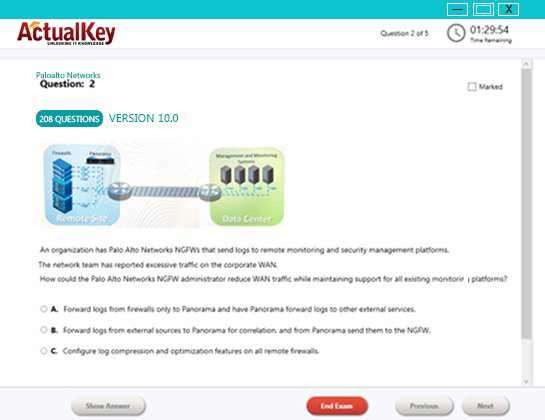Limited Time 30% Discount Offer Use Code - off30
Actualkey Prepration Latest 300-740 : Designing and Implementing Secure Cloud Access for Users and Endpoints Exam Questions and Answers PDF's, Verified Answers via Experts - Pass Your Exam For Sure and instant Downloads - "Money Back Guarantee".
| Vendor | Cisco |
| Certification | Cisco Certified Network Professional |
| Exam Code | 300-740 |
| Title | Designing and Implementing Secure Cloud Access for Users and Endpoints Exam |
| No Of Questions | 61 |
| Last Updated | July 29,2025 |
| Product Type | Q & A with Explanation |
| Bundel Pack Included | PDF + Offline / Andriod Testing Engine and Simulator |
Languages English
Duration 90 minutes
Price $US, or use Cisco Learning Credits
Certifications Cisco Certified Network Professional (CCNP) Security
Cisco Certified Specialist - Security Secure Cloud Access
Passing this exam earns you the Cisco Certified Specialist - Secure Cloud Access certification and meet the concentration exam requirements for the Cisco Certified Networking Professional (CCNP) Security certification. Passing this exam also can be used towards recertification.
Designing and Implementing Secure Cloud Access for Users and Endpoints (300-740 SCAZT) v1.0 is a 90-minute exam that certifies a candidate's knowledge of designing and implementing cloud security architecture, user and device security, network and cloud security, application and data security, visibility and assurance, and threat response.
Prepare for your exam
Choose training options that work for you—learn the way you want, when you want.
Cisco U. learning path
Follow a guided Learning Path designed for your certification success. Pre- and post-assessments help you skip what you know and focus on what you need to learn.
View Cisco U. learning path
Instructor-led training
Join lively classroom-style learning and discussions, online or in person, that are led by Cisco and our Learning Partners.
Register for instructor-led training
E-learning
Access a rich library of technology and certification training, study bundles, practice exams, simulators, and more.
Explore the e-learning course
Sample Question and Answers
QUESTION 1
According to Cisco Security Reference Architecture, which solution provides threat intelligence and malware analytics?
A. Cisco pxGrid
B. Cisco XDR
C. Cisco Talos
D. Cisco Umbrella
Answer: C
Explanation:
Comprehensive and Detailed Explanation From Exact Extract:
Cisco Talos is Ciscos threat intelligence organization, delivering real-time threat intelligence and
malware analytics to help organizations detect and prevent threats before they impact the network.
According to the SCAZT guide, Talos provides comprehensive coverage of threat data including
signatures, indicators of compromise, and context-driven analytics. This intelligence feeds into Cisco
security platforms such as Cisco SecureX and Cisco Secure Endpoint to enhance detection,
investigation, and response capabilities. Talos is explicitly referenced in the Threat Response section
as the primary source of threat intelligence and malware analytics that supports cloud and endpoint
security frameworks.
Reference: Designing and Implementing Secure Cloud Access for Users and Endpoints (SCAZT) Study
Guide, Section 6: Threat Response, Pages 112-115.
QUESTION 2
Which types of algorithm does a web application firewall use for zero-day DDoS protection?
A. Reactive and heuristic-based
B. Stochastic and event-based
C. Correlative and feedback-based
D. Adaptive and behavioral-based
Answer: D
Explanation:
Comprehensive and Detailed Explanation From Exact Extract:
According to the SCAZT documentation, web application firewalls (WAFs) designed to protect against
zero-day Distributed Denial of Service (DDoS) attacks leverage adaptive and behavioral-based
algorithms. These algorithms dynamically analyze traffic patterns, baseline normal behavior, and
detect anomalies that could indicate novel or zero-day attacks. Unlike signature-based detection,
adaptive and behavioral methods adjust in real-time to emerging threats, learning from ongoing
traffic without relying on pre-defined rules. This proactive approach enables rapid detection and
mitigation of unknown DDoS vectors, critical for cloud and network security where threats evolve
constantly.
Reference: Designing and Implementing Secure Cloud Access for Users and Endpoints (SCAZT) Study
Guide, Section 3: Network and Cloud Security, Pages 75-77.
QUESTION 3
An administrator must deploy an endpoint posture policy for all users. The organization wants to
have all endpoints checked against antimalware definitions and operating system updates and
ensure that the correct Secure Client modules are installed properly. How must the administrator
meet the requirements?
A. Configure the WLC to provide local posture services, and configure Cisco ISE to receive the
compliance verification from the WLC to be used in an authorization policy.
B. Create an ASA Firewall posture policy, upload the Secure Client images to the NAD, and create a
local client provisioning portal.
C. Create the required posture policy within Cisco ISE, configure redirection on the NAD, and ensure
that the client provisioning policy is correct.
D. Identify the antimalware being used, create an endpoint script to ensure that it is updated, and
send the update log to Cisco ISE for processing.
Answer: C
QUESTION 4
Refer to the exhibit.
Refer to the exhibit. An engineer must provide HTTPS access from the Google Cloud Platform virtual
machine to the on-premises mail server. All other connections from the virtual machine to the mail
server must be blocked. The indicated rules were applied to the firewall; however, the virtual
machine cannot access the mail server. Which two actions should be performed on the firewall to
meet the requirement? (Choose two.)
A. Set IP address 192.168.200.10 as the destination in rule 1.
B. Move up rule 2.
C. Set IP address 20.1.1.1 as the source in rule 1.
D. Configure a NAT rule.
E. Configure a security group.
Answer: A, D
QUESTION 5
Refer to the exhibit.
Refer to the exhibit. A security engineer deployed Cisco Secure XDR, and during testing, the log entry
shows a security incident. Which action must the engineer take first?
A. Uninstall the malware.
B. Block IP address 10.77.17.45.
C. Isolate the endpoint.
D. Rebuild the endpoint.
Answer: C
I Got My Success Due To Actualkey 300-740 Bundle Pack Actualkey experts I got passed in the 300-740 exam without any worries at all, these exam material products gave me the reason to relax.
Budi Saptarmat
Yahoo! Got Successfully Through The 300-740 Exam Passing Exam is not a easy thanks to Acutalkey.com for providing me actual 300-740 Designing and Implementing Secure Cloud Access for Users and Endpoints Exam training with there included the Offline and Android simulators helps me success
Melinda
300-740 Exam Best Preparation I have been preparing for 300-740 Designing and Implementing Secure Cloud Access for Users and Endpoints Exam, I was not sure that I'll be able to pass because of the fact that I am not a good student however;Actualkey.com provided me best and simple exam training pdf's and I passed. I now recommend everyone
Antonio Moreno
Actualkey.com 300-740 Offline Simulator is Best My choice to select Actualkey.com and go for the preparation 300-740 Designing and Implementing Secure Cloud Access for Users and Endpoints Exam, because I got the short way with the easy way
Liliane Meichner
Actualkey.com 300-740 Exam PDF"s passed with in a week 300-740 exam pdf's that's amazing
James Wilson
Cisco - RELATED EXAMS
Implementing Cisco Unified Communications Manager Part 2 (CIPT2 v6.0)
Questions: 174 | May 8, 2024
Implementing Cisco Security Monitoring, Analysis andResponse System
Questions: 49 | May 8, 2024
Cisco Wide Area Application Services for System Engineers exam
Questions: 60 | August 1, 2024
Cisco Data Center Networking Infrastructure Solutions design
Questions: 120 | August 1, 2024
Implementing Cisco Unified Wireless Networking Essentials (IUWNE)
Questions: 203 | July 1, 2024
Associated Certifications: Cisco Storage Networking Support Specialist
Questions: 74 | August 1, 2024
Implementing Cisco Security Monitoring, Analysis, and Response System
Questions: 67 | August 1, 2024
Wide Area Application Services for System Engineers (WAASSE)
Questions: 90 | January 5, 2024
Implementing Advanced Cisco Unified Wireless Security (IAUWS)
Questions: 85 | January 7, 2024
Troubleshooting and Maintaining Cisco IP Switched Networks (TSHOOT)
Questions: 72 | January 7, 2024
Implementing Cisco Unified Communications Voice over IP and QoS v8.0 (CVOICE v8.0)
Questions: 257 | July 1, 2024
Securing Networks with Cisco Routers and Switches (SECURE) v1.0
Questions: 136 | July 1, 2024
Implementing Cisco Unified CommunicationsManager, Part 2 v8.0 (CIPT2 v8.0)
Questions: 215 | July 1, 2024
Introducing Cisco Voice and Unified Communications Administration v8.0
Questions: 300 | May 8, 2024
Integrating Cisco Unified Communications Applications v8.0 (CAPPS v8.0)
Questions: 203 | May 8, 2024
Operational Foundations for Cisco Service Provider Core Networks
Questions: 91 | May 8, 2024
Maintaining Cisco Service Provider VPNs and MPLS Networks (MSPVM)
Questions: 89 | May 8, 2024
Cisco Data Center Unified Computing Support Specialist Qualifier Exam (DCUCI Qualifier Exam)
Questions: 65 | May 8, 2024
Cisco Data Center Unified Computing Design Specialist Qualifier Exam
Questions: 62 | May 8, 2024
Designing for Cisco Internetwork Solutions Exam (DESGN) v2.1
Questions: 241 | October 1, 2024
Maintaining Cisco Service Provider Routing Protocols (MSPRP)
Questions: 70 | October 1, 2024
Maintaining Cisco Service Provider Quality of Service (MSPQS)
Questions: 91 | October 1, 2024
PSACAS Advanced Collaboration Architecture Sales Specialist Exam
Questions: 56 | May 8, 2024
PSACASE Advanced Collaboration Architecture System Engineer Exam
Questions: 64 | May 8, 2024
PSACAFE Advanced Collaboration Architecture Field Engineer Exam
Questions: 50 | August 1, 2024
Cisco IronPort Certified Security Professional (CICSP) Web Security 7.0
Questions: 66 | August 1, 2024
Implementing Cisco TelePresence Video Networking Solutions Exam
Questions: 57 | August 1, 2024
Advanced Borderless Network Architecture Systems Engineer Exam
Questions: 60 | August 1, 2024
Cisco Substation Automation System and Field Engineer Knowledge Verification
Questions: 58 | May 8, 2024
Authorized Connected Grid Account Manager Knowledge Verification
Questions: 23 | August 1, 2024
Cisco Data Center Unified Computing Systems Implementation (DCUCI)
Questions: 78 | May 8, 2024
Introduction to 802.1X Operations for Cisco Security Professionals Exam (S802DT1X)
Questions: 69 | May 8, 2024
Introducing Cisco Identity Services Engine for System Engineer Exam (PAISESE)
Questions: 34 | May 8, 2024
PASCERAM - Cisco SaaS Conferencing and EIM Resale ATP for the AM Exam
Questions: 35 | May 8, 2024
Cisco SP Video Wireline & Cable Headend Design Specialist for SE
Questions: 33 | May 8, 2024
PASCERSE - Cisco SaaS Conferencing and EIM Resale ATP for the SE Exam
Questions: 56 | May 8, 2024
Building Cisco Service Provider Next-Generation Networks, Part 2
Questions: 126 | May 8, 2024
Building Cisco Service Provider Next-Generation Networks, Part 1 Exam
Questions: 257 | October 25, 2024
Implementing Advanced Cisco Unified Wireless Security (IAUWS) v2.0
Questions: 206 | May 8, 2024
Deploying Cisco Service Provider Network Routing (SPROUTE)
Questions: 174 | January 12, 2024
Implementing Cisco Service Provider Next-Generation Core Network Services (SPCORE)
Questions: 184 | January 12, 2024
Implementing Cisco Service Provider Next-Generation Edge Network Services (SPEDGE) Exam
Questions: 185 | January 12, 2024
Implementing and Maintaining Cisco Technologies Using IOS XR - (IMTXR)
Questions: 77 | January 12, 2024
Designing and Implementing Cisco Unified Communications on Unified Computing Systems - DIUCUCS
Questions: 60 | January 12, 2024
Implementing and Configuring Cisco Identity Service Engine - SISE
Questions: 49 | July 1, 2024
PASCERFE - Cisco SaaS Conferencing and EIM Resale ATP for the FE Exam
Questions: 53 | July 1, 2024
Advanced Borderless Network Architecture Field Engineer Exam
Questions: 86 | January 15, 2024
Advanced Borderless Network Architecture Systems Engineer Exam (700-303)
Questions: 156 | January 15, 2024
Cisco Implementing Cisco Secure Mobility Solutions Exam (SIMOS)
Questions: 543 | May 17, 2024
Unified Communications Contact Center Express Implementation - UCCX
Questions: 50 | January 15, 2024
Performing Business-Focused Transformative Architecture Engagements
Questions: 67 | January 17, 2024
Configuring Cisco UCS and Cisco Catalyst 3000 for Vblock Series 100
Questions: 45 | January 17, 2024
Cisco Application Centric Infrastructure for System Engineers
Questions: 58 | January 17, 2024
Implementing Cisco Service Provider Mobile Unlicensed Small Cell Solutions
Questions: 51 | January 17, 2024
Securing Cisco Networks with Sourcefire Intrusion Prevention System
Questions: 59 | January 17, 2024
Implementing Cisco Service Provider Mobility UMTS Networks (SPUMTS)
Questions: 70 | January 17, 2024
Implementing Cisco Service Provider Mobility CDMA Networks (SPCDMA)
Questions: 70 | January 17, 2024
Implementing Cisco Service Provider Mobility LTE Networks (SPLTE)
Questions: 70 | January 17, 2024
Integrating Business Applications with Network Programmability (NPIBA)
Questions: 66 | January 17, 2024
Managing Industrial Networks with Cisco Networking Technologies (IMINS)
Questions: 64 | January 17, 2024
Designing with Cisco Network Programmability for ACI (NPDESACI)
Questions: 60 | January 17, 2024
Implementing with Cisco Network Programmability for ACI (NPENGACI)
Questions: 60 | January 17, 2024
Cisco Application Centric Infrastructure for Account Managers
Questions: 41 | January 17, 2024
Executing Cisco Advanced Business Value Analysis and Design Techniques
Questions: 60 | July 1, 2024
Troubleshooting and Maintaining Cisco IP Networks (TSHOOT)
Questions: 254/24Case Study | January 18, 2024
Cisco Application Centric Infrastructure for Field Engineers Exam
Questions: 50 | September 16, 2024
Implementing and Supporting Cisco Unified Contact Center Enterprise Exam
Questions: 95 | September 16, 2024
Executing Cisco Advanced Business Value Analysis and Design Techniques
Questions: 182 | September 16, 2024
Applying Cisco Specialized Business Value Analysis Skills
Questions: 173 | September 16, 2024
Cisco Implementing Cisco Wireless Network Fundamentals Exam
Questions: 509 | September 16, 2024
Managing Industrial Networks for Manufacturing with Cisco Technologies
Questions: 87 | September 16, 2024
Cisco Implementing and Troubleshooting the Cisco Cloud Infrastructure Exam
Questions: 132 | September 16, 2024
Building the Cisco Cloud with Application Centric Infrastructure
Questions: 60 | September 16, 2024
Cisco Leading Virtual Classroom Instruction - Written Exam
Questions: coming soon | September 16, 2024
Cisco Leading Virtual Classroom Instruction - Practical Exam
Questions: coming soon | September 16, 2024
Integrating Business Applications with Network Programmability
Questions: coming soon | January 19, 2024
Cisco Implementing Cisco Data Center Virtualization and Automation Exam
Questions: 167 | January 21, 2024
Cisco Midsize Collaboration Solutions for Account Managers (MCAM)
Questions: 30 | April 11, 2024
Cisco Data Center Unified Computing Infrastructure Design (DCICUC)
Questions: 40 | January 21, 2024
Cisco Enterprise Networks SDA, SDWAN and ISE Exam for System Engineers
Questions: 35 | January 21, 2024
Automating and Programming Cisco Security Solutions (SAUTO) Exam
Questions: 332 | May 9, 2024
Implementing and Operating Cisco Enterprise Network Core Technologies (ENCOR) Exam
Questions: 380 | October 15, 2025
Implementing and Operating Cisco Data Center Core Technologies (DCCOR) Exam
Questions: 669 | June 4, 2025
Implementing Cisco Enterprise Advanced Routing and Services (ENARSI) Exam
Questions: 630 | December 4, 2025
Understanding Cisco Cybersecurity Operations Fundamentals (CBROPS) Exam
Questions: 451 | October 2, 2025
Designing Cisco Enterprise Wireless Networks (300-425 ENWLSD) Exam
Questions: 256 | September 2, 2025
Implementing Cisco Enterprise Wireless Networks (300-430 ENWLSI) Exam
Questions: 216 | November 8, 2024
Automating and Programming Cisco Enterprise Solutions (ENAUTO 300-435) Exam
Questions: 125 | November 8, 2024
Designing Cisco Data Center Infrastructure (300-610 DCID) Exam
Questions: 277 | October 20, 2025
Troubleshooting Cisco Data Center Infrastructure (300-615 DCIT) Exam
Questions: 517 | November 8, 2024
Implementing Cisco Application Centric Infrastructure (300-620 DCACI) Exam
Questions: 247 | May 22, 2025
Implementing Cisco Storage Area Networking (300-625 DCSAN) Exam
Questions: 60 | November 8, 2024
Implementing and Configuring Cisco Identity Services Engine (300-715 SISE) Exam
Questions: 306 | November 28, 2025
Securing Email with Cisco Email Security Appliance (300-720 SESA) Exam
Questions: 147 | November 8, 2024
Securing the Web with Cisco Web Security Appliance (300-725 SWSA) Exam
Questions: 60 | November 8, 2024
Implementing Secure Solutions with Virtual Private Networks (SVPN 300-730) Exam
Questions: 175 | November 8, 2024
Implementing Cisco Collaboration Applications (300-810 CLICA) Exam
Questions: 213 | November 8, 2024
Implementing Cisco Advanced Call Control and Mobility Services (300-815 CLACCM) Exam
Questions: 242 | September 13, 2025
Implementing Cisco Collaboration Cloud and Edge Solutions (300-820 CLCEI)
Questions: 207 | August 3, 2025
Implementing DevOps Solutions and Practices using Cisco Platforms (300-910 DEVOPS) Exam
Questions: 130 | November 8, 2024
Developing Applications for Cisco Webex and Webex Devices (300-920 DEVWBX) Exam
Questions: 60 | November 8, 2024
Implementing and Operating Cisco Service Provider Network Core Technologies (350-501 SPCOR)
Questions: 501 | September 15, 2025
Implementing and Operating Cisco Security Core Technologies (SCOR 350-701) Exam
Questions: 689 | June 5, 2025
Implementing Cisco Collaboration Core Technologies (350-801 CLCOR) Exam
Questions: 361 | August 3, 2025
Developing Applications using Cisco Core Platforms and APIs v1.0 (DEVCOR 350-901) Exam
Questions: 434 | October 20, 2025
Designing Cisco Unified Contact Center Enterprise (UCCED) Exam
Questions: 93 | November 8, 2024
Implementing Cisco Application Centric Infrastructure - Advanced (600-660 - 300-630 DCACIA)
Questions: 76 | November 8, 2024
Supporting Cisco Routing and Switching Network Devices v3.0 - RSTECH Exam
Questions: 72 | November 8, 2024
Cisco Security Architecture for System Engineers (ASASE) Exam
Questions: 92 | November 8, 2024
Implementing Cisco Service Provider Advanced Routing Solutions (SPRI) Exam
Questions: 269 | April 12, 2025
Implementing Cisco Service Provider VPN Services (300-515 SPVI) Exam
Questions: 71 | November 8, 2024
Developing Solutions Using Cisco IoT and Edge Platforms (DEVIOT) Exam
Questions: 60 | November 8, 2024
Conducting Forensic Analysis and Incident Response Using Cisco CyberOps Technologies (CBRFIR) Exam
Questions: 116 | August 30, 2025
Performing CyberOps Using Core Security Technologies (CBRCOR) Exam
Questions: 139 | May 10, 2024
Implementing Cisco Collaboration Conferencing (CLCNF) Exam
Questions: 60 | September 16, 2024
Implementing Cisco SD-WAN Solutions (ENSDWI) Exam Corresponding Certification: CCNP Enterprise
Questions: 163 | September 16, 2024
Cisco Data Center Unified Computing Infrastructure Troubleshooting Exam
Questions: 40 | September 16, 2024
ENCOR Implementing and Operating Cisco Enterprise Network Core Technologies
Questions: 747 | May 10, 2024
Cisco Advanced Administration and Reporting of Contact Center Enterprise Exam
Questions: 60 | July 1, 2024
Cisco Certified Support Technician (CCST) Networking Exam
Questions: 40 | November 7, 2024
Cisco Collaboration SaaS Authorization for PreSales Engineer Exam
Questions: 60 | September 4, 2024
Implementing Cisco Application Centric Infrastructure - Advanced Exam
Questions: 119 | April 4, 2025
Designing and Implementing Secure Cloud Access for Users and Endpoints Exam
Questions: 61 | July 29, 2025
Cisco Certified Support Technician (CCST) Cybersecurity Exam
Questions: 50 | August 16, 2025
Designing and Implementing Cisco Service Provider Cloud Network Infrastructure v1.0 Exam
Questions: 61 | December 6, 2025
Exams code, certifications, vendor or keywords
![]()
Copyright © 2009 - 2026 Actualkey. All rights reserved.





